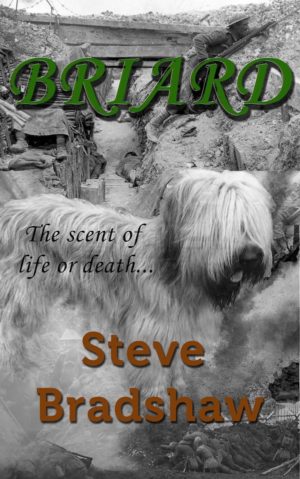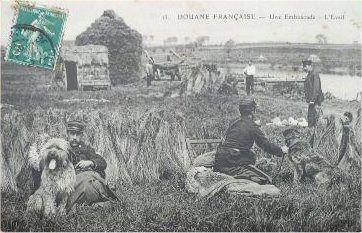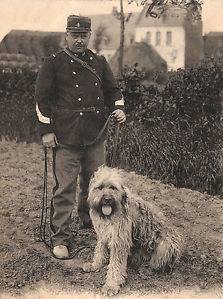
Carrying messages was one of the important uses of dogs during World War I; telegraph and telephone lines were often cut by the enemy, and dogs were faster and smaller targets than soldiers.
It was hard work.
Wearing a collar fitted with a metal tube containing a message, dogs had to run long distances over varied terrain while overcoming obstacles like fallen trees (or soldiers), crawling through barbed wire, and crossing rivers. They were expected to get to their destination, and then return with a reply to their handler, a dog that whom Edwin H. Richardson (founder of the first British Dog Training School and authority on 20th century war dogs) called a “keeper.”
Nor surprisingly, the messenger dog was considered to be the most elite canine on the front, and armies that used them saw significant reductions in human casualties. The French went a bit further by dividing messenger war dogs into two categories: Estafettes and Liaison dogs.
Estafettes dogs were trained to run with a message from one point to another, and training them took about six weeks. Liaison dogs required nearly twice the amount of time to train as the Liaison dogs because they had to recognize two handlers, and be receptive to being directed by one to return to the other. These dogs could be sent back and forth regularly between the front to battalion headquarters, and they had to travel silently and take advantage of natural cover when moving between the two handlers. In other words, they had to make a round trip over dangerous ground. The most desired quality in these dogs was loyalty since they had to be motivated by the desire to work with two handlers.
A total of 340 dogs were sent to France from the British training school within a certain period of World War I, and according to “Chaz” writing for Owlcation, they included 74 Collies, 70 lurchers (a sighthound bred with another breed), 66 Airedales, 36 sheepdogs, 33 retrievers, and the rest made up of 13 different breeds. No mention is made of another breed which is somewhat remarkable because Briards were so good at their tasks that the enemy purposefully aimed at them and killed so many that it nearly drove the breed to extinction.
Today, the work of these dogs is remembered in “Messenger dog trials,” also known as rapporthund, a form of canine competition based on the work of military dogs who delivered messages. As it was done during the war, Rapporthund is a team sport consisting of a dog and two handlers. The dog runs a relatively long distance between two handlers (often a husband/wife or parent/child team) to “deliver a message” within a set time, and s/he must do so without barking, whining, or making excessive noise.
Competition messenger dog trials are held primarily in Scandinavia, especially in Sweden (which explains why videos we found on Rapporthund were narrated in Swedish).
In novice competition, a dog must traverse 1 km (2 legs of 500 m) within 7 minutes combined time (the clock is
suspended at each stopping point). In expert competition, s/he must traverse 6.1 km (comprised of legs of 1100 + 1500 + 1500 + 2000 m) within 36 minutes. Depending upon the terrain, the fastest dogs seem to accomplish this between 13 to 17 minutes. Several trips back and forth between two handlers make up the distance: One handler stays put, while the other one walks farther away with each trip so that the dog must track the scent to find the handler. In scoring, the fastest dog gets 290 points, and for every 90 seconds slower than the fastest time, 14.5 points are deducted.
Ingrid Bahlenberg, a event judge and competitor, says that Rapporthund is very much about recollection training. Even if you don’t understand the language, the video below of a such an event offers a glimpse into the sport. As we watched this the first time, we couldn’t help but imagine bullets flying through air acrid with the smell of destruction as brave dogs did what was asked of them. It tugs at the heart.
If you’re interested, there’s an Instagram page called #rapporthund that shows the different breeds that take part in the sport. As for our thumbnail image, we don’t often use the cover of a book, but felt that in this case, the story of “Serges,” a Briard enlisted in the French army seemed appropriate. You can learn more about the book here.


